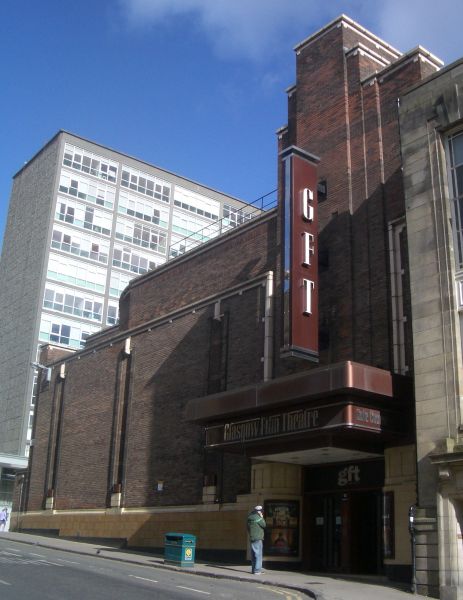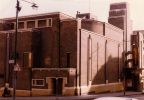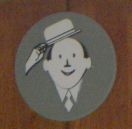
Click here for a gallery of exterior photos
|
Opening in May 1939, the
Cosmo cinema
was the first purpose-built 'art-house' cinema to open outside of
London. Designed as the flagship for the Singleton chain (which also
included the Kingsway, Mecca and Riddrie cinemas in Glasgow), this
850-seater was prolific cinema architect James McKissack's final design
before his death.
The building sits on a
sloping site
on Rose Street, and is set back from the existing building line. A
large stepped tower
advertises the cinemas presence to passers by
in Sauchiehall Street.
Clad in brown brick with cream details, the
massing of the tower and linear
light wells are in contrast to the
curving portions that mirror the shape of the auditorium within. |
The foyer was originally
double-height, with twin staircases leading to the balcony. Payboxes
were situated to both the left and right, between the two sets of
entrance doors. A small kiosk was situated at the back of the foyer,
which was panelled in walnut. A large globe, set above the main rear
stalls entrance, reinforced the international nature of the films being
shown. A large cloakroom and luxurious ladies powder room were also
provided.
The
cinema was advertised under the
slogan 'Entertainment for the Discriminating', with the cartoon
character of the bowler-hatted Mr
Cosmo a familiar sight in newpaper
advertisments of the time.
In 1968, the foyer was dramatically altered to become single height,
and a new
bar
was incorporated over it, in a style that matched the rest of the
interior decoration very well. Part of one of the twin staircases was
also removed at this point..
|

Click here for a gallery of foyer & cafe pictures
|
In 1973, the Cosmo was bought by the Scottish Film Council,
who undertook major structural alterations. The auditorium was split,
to form a large single screen upstairs, with the balcony extended fully
forward and a new proscenium constructed.

Click here for a gallery of Screen 1 pictures
|
Much
of the original decoration was retained, including the central light
feature nicknamed 'Mr Cosmo's Bowler
Hat', as well as the curving
side
walls and decorative covers to the ventilation system. As GFT
Cinema 1,
this area now seats 394 with 4 wheelchair spaces. The projection room
for this screen is very flexible, and can show anything from 16mm to
70mm film. It is also the only remaining cinema in western Scotland
with the
capability to show 70mm.
|
Renamed the Glasgow Film Theatre - or as it's
better known - the GFT - the building reopened to the public in May
1974.
At this time, the stalls space was used as an conference and
exhibition area. In 1986 the GFT became independant of the SFC,
and in 1988, the building
was B-listed
by Historic Scotland.
In
1988, part of the original stalls space was converted into a second
screen (currently seating 142 + 2 wheelchair spaces), and the rest into
a cafe-bar, which in a nod to the cinemas past was named Cafe Cosmo.
The rake in Screen 2 runs in the opposite direction to that of the
original stalls; it appears that this was necessary to be able to fit
the new screen under the low ceiling formed by the original balcony.
Screen 2
has its own projection room,
positioned roughly where the original
screen would have been.
|

Click here for a gallery of Screen 2 pictures
|
In 2005, despite strong competition from the nearby UGC, the GFT is thriving, and is without doubt
the most pleasant place in Glasgow to go see a film on the big screen...
Photos of the GFT from 2001 are available here |

|

|
Click here for interior pictures c2002
courtesy of Emma Taylor |
 |
1980s photos courtesy of Chris Doak |
 |
References:
1. One Hundred Years of Glasgow's Amazing
Cinemas,
Bruce Peter, Polygon (1996),
ISBN: 0748662103
Tom Widdows, Unpublished
Dissertation, Robert Gordon University (2003)
3. TheGlasgowStory.com
Many thanks to John Letham and the staff of the GFT for
their time in showing us around the building.
|










